Maha Kumbh: Who are Naga Sadhus? know interesting facts about them | Pics
-
 Image Source : pti
Image Source : ptiNaga Sadhus have a long history as evidence of their heritage can be found in the coins and paintings of Mohenjo-Daro. These ancient pieces depict Naga sadhus worshipping Lord Shiva in the Pashupatinath form.
-
Image Source : pti
Naga Sadhus are revered ascetics known for their intense spiritual practices and complete renunciation of worldly possessions.
-
Image Source : pti
During the Maha Kumbh Mela, they play a significant role, symbolising the spirit of devotion and penance. Their presence adds a mystical dimension to the fair, attracting pilgrims and tourists alike.
-
Image Source : pti
Becoming a Naga Sadhu requires immense courage and commitment, as they cannot use worldly items to adorn their bodies; instead, they apply ash on themselves, which becomes their form of adornment.
-
Image Source : pti
Naga Sadhus do not wear clothes, except for a saffron cloth, which does not fully cover the body. They also observe strict celibacy and follow a sattvic diet.
-
Image Source : pti
The unique lifestyle and rituals of Naga Sadhus make them a central attraction and serve as a reminder of the profound spiritual significance of the Maha Kumbh Mela.
-
Image Source : pti
Naga Sadhus play a significant role in the Kumbh Mela, especially during the Shahi Snan, a sacred ritual that acknowledges their spiritual importance.
-
Image Source : pti
As the sun rises over the sacred rivers, Naga Sadhus march in processions accompanied by chants, drums, and the sound of conch shells, reflecting their traditions.
-
Image Source : pti
The origin of Naga Sadhus dates back to ancient India when they were established as warrior-ascetics to protect Sanatan Dharma. Naga Sadhus possessed skills in weaponry such as swords, tridents, maces, bows, and arrows to safeguard temples.
-
Image Source : pti
Naga Sadhus successfully defended Shiva temples from invaders and Mughals. Their dual identity as warriors and spiritual seekers continues to be reflected in their practices to this day.